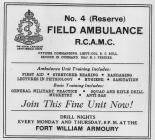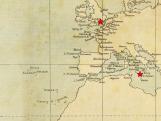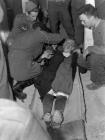1
Second World War PeriodWhen war broke out once again in Europe in the fall of 1939, 4 Field Ambulance was among the first to be mobilized. Recruits came from a wide variety of sources. Hospitals, local units and the rest of Military District 10 supplied the recruits that would bring the unit up to full strength, once again under McCartneys command.
2
Recruiting Ad8 April 1943
Fort William, Ontario
 Credits:
Credits:Jan Morrison
Thunder Bay Miltiary Museum and History Society
3
On December 15, 1939, a mere three months after war was declared, the unit left the Lakehead for Halifax by train. Before the end of the year, they sailed to Glasgow, Scotland as part of the 1st Division. Once in the United Kingdom, they would continue training at Camp Aldershot, just southwest of London England.4
4th Field Ambulance1939
Aldershot, England
 Credits:
Credits:Thunder Bay Miltiary Museum and History Society
5
Training at Aldershot was finished on June 6, 1940. Within one week, the unit had landed in France where the whole 1st Division was preparing to join the Paris Garrison. At this time, 4 Field Ambulance was one of only two Canadian units to set foot in France before its fall in 1940. The other was the Hastings and Prince Edward Regiment. On their way to Paris however, France gave up and they were forced to turn around, arriving in back in England on June 15, 1940.6
4 Field Ambulance First on French Soil31 March 1940
Fort William, Ontario
 Credits:
Credits:Thunder Bay Miltiary Museum and History Society
Fort William Daily Times Journal
7
While in back England, the unit assisted the 2nd Canadian Division in Brighton with casualties coming back from the Dieppe operation in August 1942.On June 27, 1943, the unit sailed to Sicily and landed on July 10 as part of the 2nd Canadian Corps, 8th Army during the Allied invasion.
8
Sicily, Italy27 June 1943
Sicily, Italy
 Credits:
Credits:Thunder Bay Miltiary Museum and History Society
Nick Sottile
9
For the majority of the rest of the war, 4 Field Ambulance was assigned as Medical unit for the 1st Infantry Brigade (Royal Canadian Regiment, Hastings and Prince Edward Regiment, 48th Highlanders). From their landing in southern mainland Italy on September 7, 1943 until reaching the Senio River in the north on March 1, 1945, the unit provided medical support for Allied troops at these and other battles: THE MORO
SAN LEONARDO
The Gully
ORTONA
Sano Nicola San Tommaso
Naviglio Canal
Fosso Vecchio
Cassino II
Gustav Line
Liri Valley
HITLER LINE
GOTHIC LINE
LAMONE CROSSING
Misano Ridge
RIMINI LINE
SAN FORTUNATO
Bulgaria Village
San Martino San Lorenzo
Pisciatello
Fosso Vecchio
10
Major P.K.Tisdale treats wounded Italian woman at Advanced Dressing Station of 4 Field Ambulance15 January 1944
San Vito di Ortona, Italy
 Credits:
Credits:Lieut. Alex M. Stirton / Canada. Dept. of National Defence / Library and Archives Canada / PA-114038
11
During April of 1945, 4 Field Ambulance would find themselves in Holland where the 1st Canadian Corps was in charge of containing enemy Germans. May 8th saw the unconditional surrender of Germanyand the movement of 4 Field Ambulance out of Holland.
After leaving the Lakehead more than five years before, 4 Field Ambulance returned home to the new Fort William Armoury on September 2, 1945. On this date, the 12 officers and 230 other ranks of the unit were officially demobilized.
12
Fort William Amroury Opening is Military Milestone10 April 1943
Fort William, Ontario
 Credits:
Credits:Thunder Bay Miltiary Museum and History Society
Fort William Daily Times Journal
13
As in WWI, many would receive honours. Among those receiving honours during the war was Warrant Officer William David Holbrook. WO Holbrook was made a member of the Order of the British Empire in recognition of his service.14
WO Holbrook Awarded MBE29 December 1941
Fort William, Ontario
 Credits:
Credits:Thunder Bay Military Museum and History Society
Fort William Times Journal
Jan Morrison